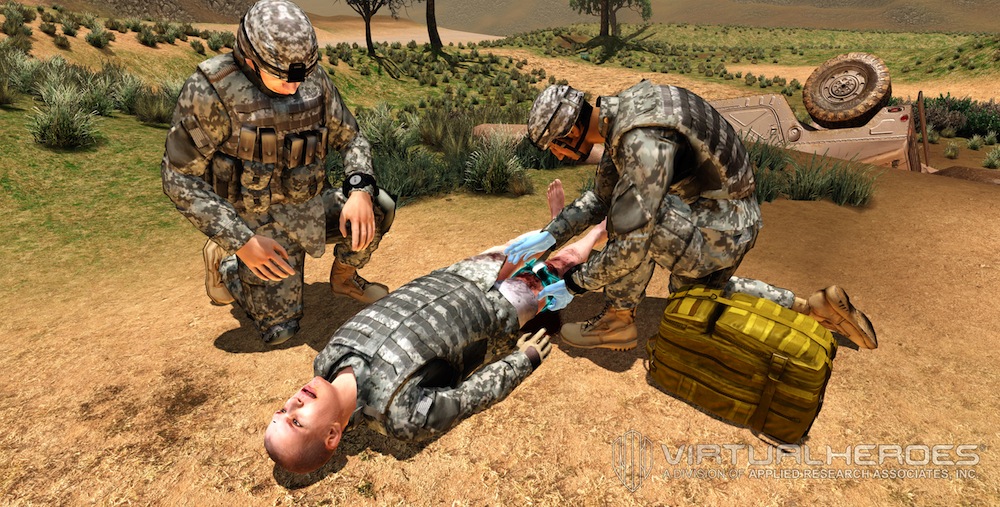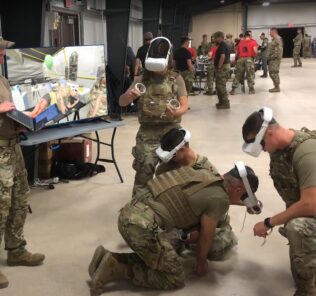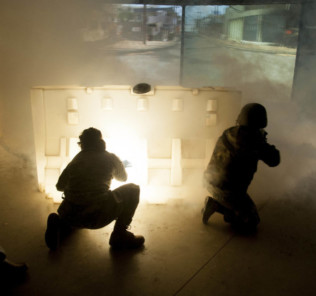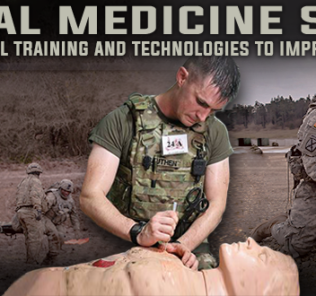Serious Games for Serious Simulation, An In-depth Look at Combat Medic from Virtual Heroes
Serious Games for Serious Simulation, An In-depth Look at Combat Medic from Virtual Heroes

Written By: Steve Melito
Thunderbolt Business Services
Sponsored Content:
Combat Medic, a game-based system from Virtual Heroes, Inc., is a digital example of MedSim’s use in the U.S. military. This serious game from the Orlando-based division of Advanced Research Associates (ARA) helps prepare medical personnel to treat the top three causes of battlefield deaths: hemorrhage, airway management, and tension pneumothorax.
Steve Melito, a MedSim writer, recently interviewed Virtual Heroes Division Manager Randy Brown for an article in Combat & Casualty Care (C&CC) magazine. Brown was joined by Steve McIlwain, a senior producer. Excerpts from the interview appear in C&CC, but the full interview appears here on HealthySimulation.com.
1) What are some of the most important features and capabilities that you’d like readers to know about Combat Medic?
Combat Medic is the next step in serious gaming technology. We have effectively combined state-of-the-art game engine technology, medically accurate casualty conditions, and immersive environments, to create something truly special. To accommodate many training needs, we designed this application to deliver content through self-directed, team-based, and instructor-led training methods. Our overall goal was to prepare combat medics to treat the top three causes of preventable deaths on the modern battlefield: hemorrhage, airway management, and tension pneumothorax.
Sponsored Content:
To maximize the learning benefit and scalability of the application, we integrated a robust difficulty system. This difficulty system introduces increasingly more challenging treatment scenarios. The system also increases the overall cognitive load of the participant by means of various distractions within the environment. The real-time, interactive immersion enables the cognitive load to resonate with the user. In theory, this translates to better handling of distractive elements encountered during real casualty treatment. Randomized variation of injuries aids in the neuroplasticity of the participant—they don’t just learn how to complete the training, they learn appropriate treatment methods.
A great feature of Combat Medic is its versatility. The application is highly customizable. For example, users may choose the contents and configuration of their aid bags; this stresses the importance of organization and preparation prior to casualty treatment, and it accommodates for varying equipment availability within the field. And Combat Medic is not only fantastic for individual training, but team training as well. During team exercises, users have the option to communicate using microphone-enabled headsets, which allows for effective team communication, triaging, and treatment coordination.
A critical component of any virtual training environment is performance assessment. We took a multi-pronged approach to assessment, to reach a larger demographic and to allow for different training environments. Our assessment system includes standard GO/NO GO performance criteria, casualty condition information, participant actions, and the ability to graphically view the casualty’s vitals throughout the scenario, as a function of elapsed scenario time. When a scenario is finished, participants and instructors can play the scenario back in full 3D with synchronized audio, to evaluate treatment performance and to identify areas for improvement.
Arguably the most important aspect of any training application is its accuracy. To achieve a true-to-life casualty physiological response during each scenario, we integrated our open-source BioGears® Physiology Engine. This validated engine accurately simulates the effects of participants’ actions on the casualty’s physiological condition. At the same time, it provides real-time casualty vitals with dynamic casualty behavior, based on the current physiological state.
Finally, a training application must be accessible. For Combat Medic to be easily available to medics around the world, it needs a relatively seamless method of deployment. For this, we use our proprietary Go Platform. Says Randy Brown, Virtual Heroes Division Manager, “the Go Platform is an exciting technology that combines simplified browser-based application delivery, virtual meeting spaces for mission briefing / debriefing discussions, interactive playback of training sessions, and modularity for future expansion.”
Read the full interview by clicking on the read more link below!
2) Please describe how Virtual Heroes worked with the U.S. military to meet the requirements for this training and simulation tool. What was the process like? How did project managers, developers, and testers acquire the subject matter knowledge that they needed?
The realism and accuracy of Combat Medic is fundamental to its success as an effective training tool. We pursued numerous avenues to validate and refine the application. Prior to the start of development, we enlisted the aid of subject matter experts (SMEs). Two former Army combat medics defined the appropriate treatment techniques and proper procedures for each of our scenarios. While working with the medics in the early stages of development, we identified several areas where a virtual experience could supplement traditional hands-on-training and better prepare medics for tactical care situations. To properly complement the expertise provided by the medics, we worked with several clinical doctors at Duke University to further refine our physiological models.
For the application to be adopted by various combat medic training programs, we needed to implement a consistent and agreed upon measure of participant evaluation and treatment procedures. To do so, we heavily referenced the U.S. Army Medical Department’s 68W Advanced Field Craft Combat Medic Skills textbook. Additionally, it was critical that we get a Beta version of the application in the hands of our target demographic, to determine the application’s overall usability and user engagement. During development, we performed a Beta test at Fort Bliss in Texas and worked extensively with combat medics at the base to refine the application to ensure maximum accuracy.
Finally, our development process was overseen closely by the Army Research Laboratory Simulation and Training Technology Center (STTC). We collaborated extensively with STTC, as well as the SMEs, from Combat Medic’s inception to its final delivery. We held bi-weekly meetings to ensure project direction and scope were on target. For each milestone delivery, we conducted in-person meetings, conference calls, and on-line collaborative game-play sessions. Every detail of the game was meticulously designed, crafted, and guided by STTC and the SMEs. They were heavily involved with our Game Design Document (GDD) as well, which details every aspect of the game. The GDD is 200+ pages in length, having undergone numerous reviews with our experts; we recorded, scoped, and prioritized their feedback. “This process of continual iteration throughout the development cycle of Combat Medic was vital to ensure every facet of the game is realistic and immersive,” stated Brad Willson, Virtual Heroes Lead Game Designer.
3) How do users interact with Combat Medic? Do they wear goggles and a headset, manipulate a joystick, use a keyboard, etc.?
To play the application, a user must have a stable internet connection and access to any personal computer that meets the following minimum system requirements:
- Windows XP SP3 (32-bit only), Windows Vista, or Windows 7
- 2.0+ GHz processor
- 2 GB system RAM
- SM3-compatible video card
- 3 GB free hard drive space
The user can navigate the application by means of a standard computer keyboard and mouse. Additionally, to take full advantage of the multiplayer functionality of the application, we recommended a VOIP-enabled headset.
4) When Combat Medic is operated in multi-player mode, do players go on missions or pass through particular scenarios? If so, what are some of these missions or scenarios like?
“We felt it was important to blur the lines between single-player and multi-player experiences,” says Steve McIlwain, Senior Producer on the project. “In the theater of battle, there are no guarantees that other soldiers will be present to provide aid; therefore, we didn’t want to artificially separate the experiences. There is seamlessness in playing the application solo or with other participants.”
Within the application, any participant can create a new game session, specify the scenario parameters, set the difficulty, and invite other online users to participate. Once a game session is created, participants enter a briefing stage within a military tent environment. Voice communication is available during this stage, so users can perform the briefing, coordinate actions, and configure aid bag load-out prior to casualty treatment. Next, in the treatment stage, participants are placed in a realistic tactical care scenario, where all of their actions are scored and recorded. By implementing randomization functionality within our difficulty system, we increase the variations within each selected scenario. This reinforces the need for proper casualty assessment and management, as well as invokes a strong sense of realism. For participants to successfully stabilize and medevac the casualties, they must act quickly while effectively communicating and coordinating their efforts.
5) What level of medical experience does Combat Medic assume, and does it have progressive levels of difficulty?
This application is designed to function as a supplement to the current Army 68W military occupational specialty (MOS) training. Our intent was never to replace hands-on training, rather to enhance it. We aim to provide a learning resource that effectively mirrors the physiological response of casualties, provides a high level of scenario variation, and doesn’t require an instructor to be present, all while allowing for participant coordination regardless of the trainees physical location. This allows trainees to practice skills in a risk-free virtual environment prior to hands-on training.
Because this application is a supplement to the 68W training, there is an assumption that the participant is familiar with hemorrhage, tension pneumothorax, and airway management procedures in a tactical care environment. Even so, the application makes use of a detailed debrief performance review, in which participants can determine which of their actions are correct and which ones require further training.
To provide a progressively more challenging and visceral experience, we incorporated a three-tier difficulty system. The difficulty setting determines the number of casualties present, the severity of the injuries, and the overall cognitive load on the participant. Additionally, numerous in-game scenario variables are randomized, to provide a unique gameplay experience.
6) Is Combat Medic available only to your clients, such as the Simulation and Training Technology Center (STTC)? In other words, if medics from another branch of the military wanted to use it, could they acquire it?
Combat Medic is available for any military branch to use, and we’re working with STTC to provide a hosting site for easy access to the military and potentially others world-wide.
About the Interviewer: Steve Melito is an award-winning content developer specializing in manufacturing, material science, and homeland security. A LinkedIn Open Networker (LION), he is the founder and owner of Thunderbolt Business Services, a content development agency with clients and partners in New York, Montreal, Los Angeles, and New Delhi.
Learn more at VirtualHeroes.com
Lance Baily, BA, EMT-B, is the Founder & CEO of HealthySimulation.com, which he started while serving as the Director of the Nevada System of Higher Education’s Clinical Simulation Center of Las Vegas back in 2010. Lance is also the Founder and acting Advisor to the Board of SimGHOSTS.org, the world’s only non-profit organization dedicated to supporting professionals operating healthcare simulation technologies. His co-edited Book: “Comprehensive Healthcare Simulation: Operations, Technology, and Innovative Practice” is cited as a key source for professional certification in the industry. Lance’s background also includes serving as a Simulation Technology Specialist for the LA Community College District, EMS fire fighting, Hollywood movie production, rescue diving, and global travel. He and his wife Abigail Baily, PhD live in Las Vegas, Nevada with their two amazing daughters.
Sponsored Content:



















